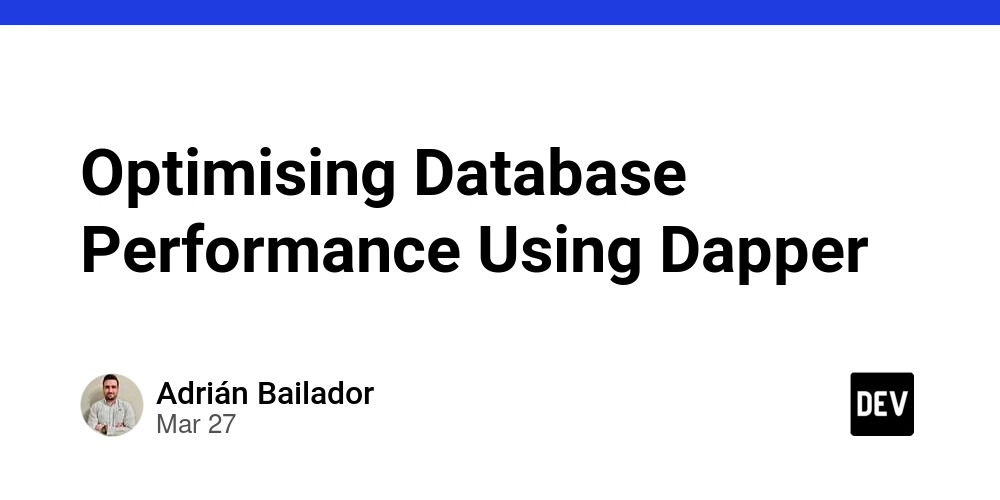Optimising Database Performance Using Dapper
Dapper is a lightweight micro-ORM for .NET that offers high-speed data access while keeping things simple. Unlike full-fledged ORMs like Entity Framework, Dapper focuses on raw SQL execution with minimal overhead. If you're working on an application where performance matters, Dapper can be a great choice. In this article, we'll go over practical ways to get the best performance when using Dapper. 1. Write Efficient Queries Since Dapper runs raw SQL, poorly written queries can slow things down. Here are some best practices: Select only the columns you need (SELECT column1, column2 FROM Table instead of SELECT *). Use indexes on frequently searched columns. Keep joins simple and denormalise where necessary. Use stored procedures for repetitive queries. Check performance with execution plans (EXPLAIN in MySQL/PostgreSQL, SHOW EXECUTION PLAN in SQL Server). Example: var sql = "SELECT Id, Name FROM Customers WHERE IsActive = @IsActive"; var customers = connection.Query(sql, new { IsActive = true }).ToList(); 2. Use Parameterised Queries Always use parameterised queries to prevent SQL injection and improve efficiency: var sql = "SELECT * FROM Orders WHERE CustomerId = @CustomerId"; var orders = connection.Query(sql, new { CustomerId = 1 }).ToList(); Dapper automatically handles parameters, making your queries safer and faster. 3. Reduce Database Calls with QueryMultiple If you need to run multiple queries at once, QueryMultiple can help reduce database round trips: var sql = "SELECT * FROM Customers; SELECT * FROM Orders"; using (var multi = connection.QueryMultiple(sql)) { var customers = multi.Read().ToList(); var orders = multi.Read().ToList(); } This approach improves efficiency by fetching multiple result sets in a single request. 4. Reuse Connections Efficiently Dapper relies on ADO.NET under the hood, which benefits from connection pooling. To get the most out of it: Reuse IDbConnection instances where possible. Open and close connections efficiently to avoid unnecessary resource usage. Example: using (var connection = new SqlConnection(connectionString)) { var customers = connection.Query("SELECT * FROM Customers").ToList(); } Using using ensures connections are properly disposed of when no longer needed. 5. Optimise Bulk Inserts Dapper isn't built for bulk inserts, but you can speed things up using SqlBulkCopy for large datasets: using (var bulkCopy = new SqlBulkCopy(connectionString)) { bulkCopy.DestinationTableName = "Customers"; bulkCopy.WriteToServer(dataTable); } For smaller inserts, consider running multiple INSERT statements in a single query. If you're using SQL Server, Table-Valued Parameters (TVPs) can help: var dt = new DataTable(); dt.Columns.Add("Id", typeof(int)); dt.Columns.Add("Name", typeof(string)); using (var connection = new SqlConnection(connectionString)) { var parameters = new { Customers = dt.AsTableValuedParameter("CustomerType") }; connection.Execute("INSERT INTO Customers (Id, Name) SELECT Id, Name FROM @Customers", parameters); } 6. Use Asynchronous Queries Using Dapper’s async methods (QueryAsync, ExecuteAsync) prevents blocking, making your application more scalable: var sql = "SELECT * FROM Customers WHERE IsActive = @IsActive"; var customers = await connection.QueryAsync(sql, new { IsActive = true }); Async methods are especially useful in web applications handling many database requests simultaneously. 7. Simplify CRUD Operations with Dapper.Contrib Dapper.Contrib adds helper methods for common CRUD operations. While it's convenient, it may add some overhead compared to raw SQL: using Dapper.Contrib.Extensions; var customer = new Customer { Name = "John Doe" }; connection.Insert(customer); If performance is critical, writing direct SQL queries is usually faster. 8. Dapper vs. Entity Framework Dapper and Entity Framework serve different purposes: Feature Dapper Entity Framework Performance ⚡ Fast

Dapper is a lightweight micro-ORM for .NET that offers high-speed data access while keeping things simple. Unlike full-fledged ORMs like Entity Framework, Dapper focuses on raw SQL execution with minimal overhead. If you're working on an application where performance matters, Dapper can be a great choice.
In this article, we'll go over practical ways to get the best performance when using Dapper.
1. Write Efficient Queries
Since Dapper runs raw SQL, poorly written queries can slow things down. Here are some best practices:
- Select only the columns you need (
SELECT column1, column2 FROM Tableinstead ofSELECT *). - Use indexes on frequently searched columns.
- Keep joins simple and denormalise where necessary.
- Use stored procedures for repetitive queries.
- Check performance with execution plans (
EXPLAINin MySQL/PostgreSQL,SHOW EXECUTION PLANin SQL Server).
Example:
var sql = "SELECT Id, Name FROM Customers WHERE IsActive = @IsActive";
var customers = connection.Query<Customer>(sql, new { IsActive = true }).ToList();
2. Use Parameterised Queries
Always use parameterised queries to prevent SQL injection and improve efficiency:
var sql = "SELECT * FROM Orders WHERE CustomerId = @CustomerId";
var orders = connection.Query<Order>(sql, new { CustomerId = 1 }).ToList();
Dapper automatically handles parameters, making your queries safer and faster.
3. Reduce Database Calls with QueryMultiple
If you need to run multiple queries at once, QueryMultiple can help reduce database round trips:
var sql = "SELECT * FROM Customers; SELECT * FROM Orders";
using (var multi = connection.QueryMultiple(sql))
{
var customers = multi.Read<Customer>().ToList();
var orders = multi.Read<Order>().ToList();
}
This approach improves efficiency by fetching multiple result sets in a single request.
4. Reuse Connections Efficiently
Dapper relies on ADO.NET under the hood, which benefits from connection pooling. To get the most out of it:
- Reuse
IDbConnectioninstances where possible. - Open and close connections efficiently to avoid unnecessary resource usage.
Example:
using (var connection = new SqlConnection(connectionString))
{
var customers = connection.Query<Customer>("SELECT * FROM Customers").ToList();
}
Using using ensures connections are properly disposed of when no longer needed.
5. Optimise Bulk Inserts
Dapper isn't built for bulk inserts, but you can speed things up using SqlBulkCopy for large datasets:
using (var bulkCopy = new SqlBulkCopy(connectionString))
{
bulkCopy.DestinationTableName = "Customers";
bulkCopy.WriteToServer(dataTable);
}
For smaller inserts, consider running multiple INSERT statements in a single query. If you're using SQL Server, Table-Valued Parameters (TVPs) can help:
var dt = new DataTable();
dt.Columns.Add("Id", typeof(int));
dt.Columns.Add("Name", typeof(string));
using (var connection = new SqlConnection(connectionString))
{
var parameters = new { Customers = dt.AsTableValuedParameter("CustomerType") };
connection.Execute("INSERT INTO Customers (Id, Name) SELECT Id, Name FROM @Customers", parameters);
}
6. Use Asynchronous Queries
Using Dapper’s async methods (QueryAsync, ExecuteAsync) prevents blocking, making your application more scalable:
var sql = "SELECT * FROM Customers WHERE IsActive = @IsActive";
var customers = await connection.QueryAsync<Customer>(sql, new { IsActive = true });
Async methods are especially useful in web applications handling many database requests simultaneously.
7. Simplify CRUD Operations with Dapper.Contrib
Dapper.Contrib adds helper methods for common CRUD operations. While it's convenient, it may add some overhead compared to raw SQL:
using Dapper.Contrib.Extensions;
var customer = new Customer { Name = "John Doe" };
connection.Insert(customer);
If performance is critical, writing direct SQL queries is usually faster.
8. Dapper vs. Entity Framework
Dapper and Entity Framework serve different purposes:










































































































































































![[The AI Show Episode 142]: ChatGPT’s New Image Generator, Studio Ghibli Craze and Backlash, Gemini 2.5, OpenAI Academy, 4o Updates, Vibe Marketing & xAI Acquires X](https://www.marketingaiinstitute.com/hubfs/ep%20142%20cover.png)



























































































































![[FREE EBOOKS] The Kubernetes Bible, The Ultimate Linux Shell Scripting Guide & Four More Best Selling Titles](https://www.javacodegeeks.com/wp-content/uploads/2012/12/jcg-logo.jpg)



![From drop-out to software architect with Jason Lengstorf [Podcast #167]](https://cdn.hashnode.com/res/hashnode/image/upload/v1743796461357/f3d19cd7-e6f5-4d7c-8bfc-eb974bc8da68.png?#)






































































































.png?#)




.jpg?#)































_Christophe_Coat_Alamy.jpg?#)








































































































![Rapidus in Talks With Apple as It Accelerates Toward 2nm Chip Production [Report]](https://www.iclarified.com/images/news/96937/96937/96937-640.jpg)









































































































































